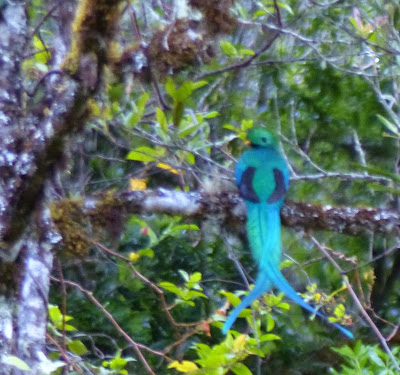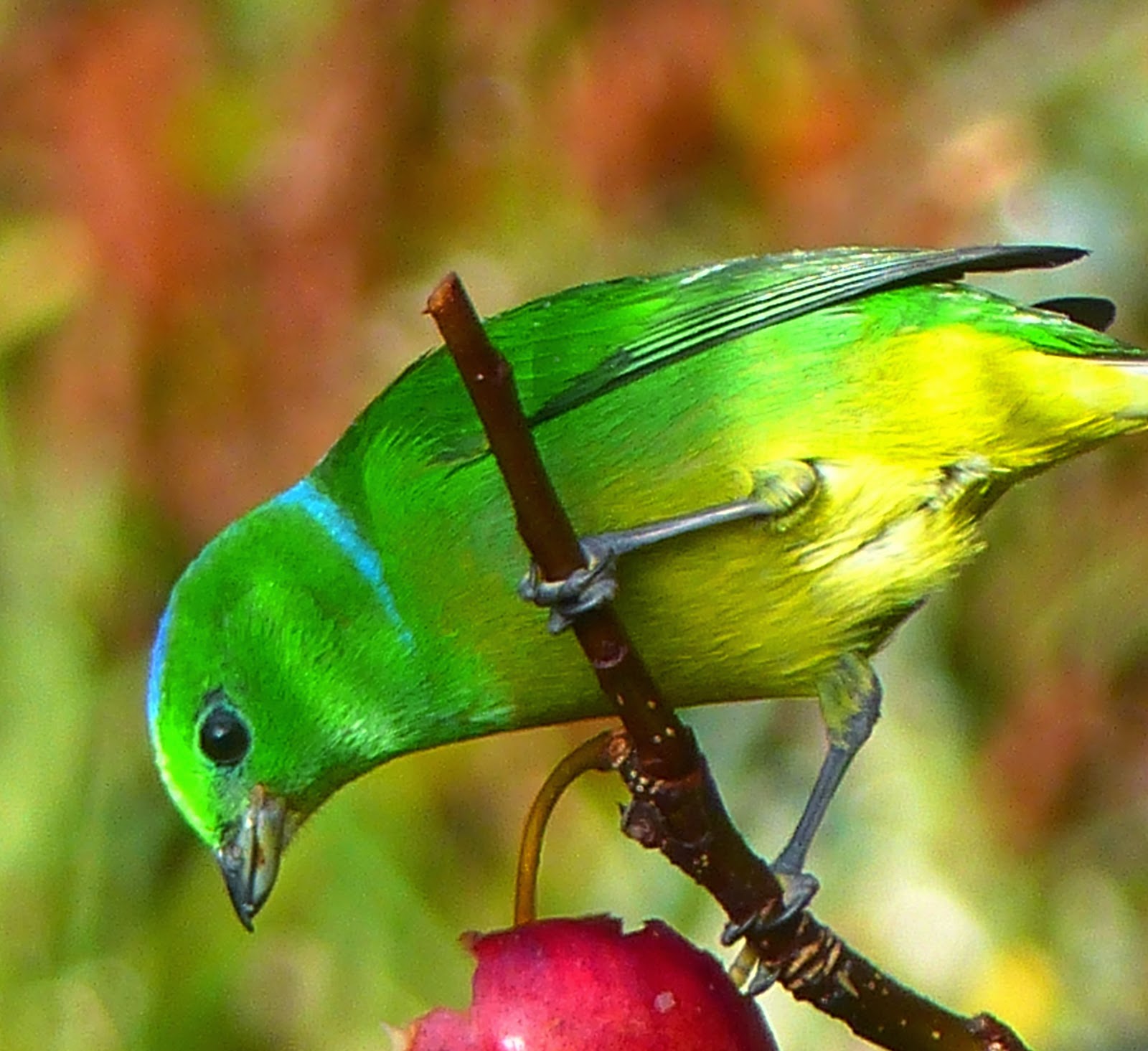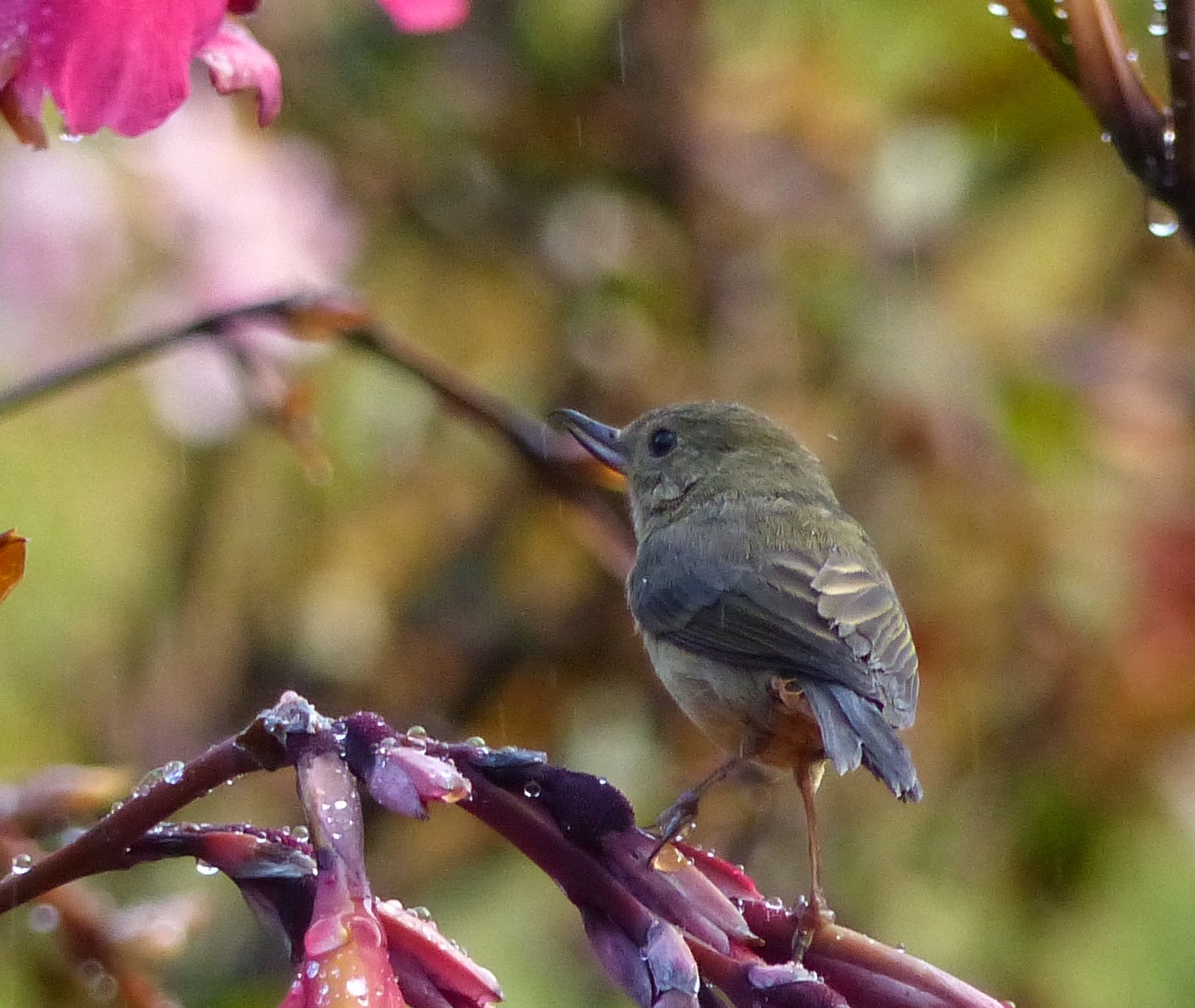It's official - we have left the chlorophonias, had breakfast, checked out and now we are leaving the highlands. A little sad, because Savegre Lodge and the highlands are great. Vernon had a final stop to make to try for an important highland bird we had missed around the lodge. He hoped to find it on some trails behind Miriam's restaurant.
Several Spotted Wood Quail (Odontophorus guttatus) were seen well but try, unless you are Matt, getting a photo of these guys. Actually I did get a couple of fuzzy photos last year when we saw the quail behind Savegre Lodge. Buffy-crowned Wood-partridge (Dendrortyx leucophrys) and Black-breasted Wood-quail (Odontophorus leucolaemus) were missed.
It was now raining for keeps - but uniquely so. The sun was shining and the sky was, more or less, blue. It was as if the sky had turned on its misters. Misty or whatever, but we got so wet! And so did the birds.
As the last one up the trail, I got several nice photos of this Mountain Elaenia. Not too wet yet, it perched on the red branch and seemed to enjoy the combination of rain and mist.
Vernon had to see Miriam, so we spent a few of our last minutes back on the deck. Look at how soaked this Black-billed Nightingale-thrush is!
Another wetter Mountain Elaenia
Same bird
I love this photo of Sooty Thrush - the water droplets can be seen on its feathers.
Again.
Now we are climbing higher. It's raining. The clouds are low and gray. We are heading to the top of the mountain location where the media and cell phone towers are planted and the only place to see Volcano Junco (
Junco vulcani). We saw it very well. Everyone got out of the van to get photos. Knowing I had photos from last year's trip, I didn't endure the windy rain. A little further down this road we also saw a little family of Timberline Wrens (
Thyrorchilus browni) and Peg-billed Finch (
Acanthidops bairdi) - both with limited high elevation ranges and both difficult to see - especially the Peg-billed finch was seen well.
We left this spot and drove to a nearby weedy and littered roadside location and piled out of the van. With no let up in the heavy rain, Vernon heard the vocalization of the Wrenthrush (
Zeladonia coronata) and we ducked into a small cave-like area of low trees, bushes and weeds. Large rain drops dripped from overhead and fell on our heads. Above this narrative and below are my horrible efforts at photographing the Wrenthrush. What saves them at all is the visible orange cap. I knew I would not be able to get good photos with my camera secondary to the bird's jumbled habitat and skulking habits. Matt has posted a relatively decent photo on his blog,
Birding Berrien and Beyond. It's not obvious from this, be we actually saw the Wrenthrush fairly well. This kind of birding experience is one I don't want to forget.
Approaching Cartago, above and below, the most amazing rainbow I have ever seen. It seemed to go on for miles.
We arrived at some railroad tracks near Cartago for a single target bird. I'll make the birds in the photo above quiz birds. They were tucked together in a tree at the edge of a small, fenced area, possibly a schoolyard, that was along the railroad tracks. If you have trouble with the ID, again, check out Matt's blog, Birding Berrien and Beyond. By now it was again raining - I mean misting - heavily and I was getting soaked so I returned to the van. We also saw a Yellow-billed Cuckoo (Coccyzus americanus)* - a very uncommon winter migrant in Costa Rica - in the trees of this yard.
*Addendum on 02/27/15: Today we received an email update from Lyle Hamilton with photo evidence that the Yellow-billed Cuckoo was, in fact, a Mangrove Cuckoo. The Birds of Costa Rica field guide describes Mangrove Cuckoo as a winter resident favoring second growth and gardens over mangroves in Costa Rica. I've never seen Mangrove Cuckoo. This won't be my life bird, but this kind of discovery gets to the heart of just one reason birding is so fun and interesting.
Above, Mangrove Cuckoo (Coccyges minor), photo by Lyle Hamilton and used with written permission.
Along with some teenage boys, this handsome dog was seeking cover from the rain on the train platform.




































































